Stulina
G.V.,
Shirokova Yu.I.,
Morozov A.N.
CURRENT WATER FORMATION
PATTERNS IN CAR AND PECULIARITIES OF HIGH-SALINE WATER USE IN IRRIGATION
UNDER CONDITIONS OF UZBEKISTAN
Abstract:
The paper describes current formation of water resources in the region
and the peculiarities of irrigation under abnormal seasonal and long-term
river flow regulation. It also grounds the main principles of using
the high-saline water in Central Asian plains, based on possible negative
effects in the soil. The paper gives theoretical approaches and analyses
results of the past research and new experiments conducted by the
authors. Moreover, it demonstrates the results of field studies and
simulations of moisture and salt transport in the soil irrigated with
high-saline water, and explains the irrigation regimes, depending
on a degree of area drainability and irrigation water salinity.
Introduction:
High-saline water is widespread in Central Asia, particularly in the
lower reaches due to inflow of drainage water from the upstream areas.
River water salinity comes to 1,5 - 2,0 g/l in the lower reaches of
the rivers Syrdarya and the Amudarya.
The problem is that historically the water sources have served also
as intakes for drainage and waste waters in the valleys of Central
Asian rivers. It is not possible to solve the problem completely in
foreseeable future; therefore, re-use of high-saline water in the
area of its formation is considered as forced.
Water formation
Primary water resources in the Central Asian Republics (CAR) are formed
by the surface flow from the rivers Amudarya and Syrdarya and their
tributaries.
The river flow is strongly variable within a year and in long-term.
Long-term flow variations depend on climate cycling.
The fluctuations of river flow are considerable from year to year:
during low-water year (90% flow probability) river flow is 20 km3
less than that of normal year.
A series of high-water years occurs in 6-10 years, its duration is
2-3 years. Low-water periods occur in 4-7 years and last for a long
time (up to 6 years).
Coefficient of river flow variation is 0,12-0,32.
The fluctuation of annual flow is wider which is explained by river
feeding. Mountain snow, snowfields, and glaciers mainly contribute
to formation of flow in larger rivers. Contribution of snow and rain
prevail in tributaries of those rivers.
The cyclicity of flow fluctuations in given rivers and the prolonged
low-water periods make it difficult to use water sources for economic
purposes, and this calls for flow regulation.
Technical capabilities of the reservoirs constructed in the Amudaray
and Syrdarya river basins allow for seasonal (Amudarya river) and
long-term (Surdarya river) regulation for the purposes of water and
power usage; however, since 1991 a part of mountain reservoirs has
been operating in power mode, thus increasing abruptly water releases
in winter period and reducing releases during growing season. Such
mode of operation reduces the chances to meet demand of upstream and
midstream irrigation water users and leads to irrigation water deficiencies
in low-water years.
In addition to above-mentioned factors, diversions for irrigation
needs and inflow of return waters affect the basins' river flow and
its hydrochemical regime. As a result, the flow underwent considerable
changes. The increase of withdrawals from the rivers to irrigation
canals and the channel losses cause the reduction of flow, while discharge
of drainage waters leads to disturbance of natural flow regime and
deterioration of quality.
Water use trends in irrigated agriculture and other water-consuming
sectors may be observed by the annual trend of consumptive water withdrawals
from the rivers, as shown in Figure 1. The figure demonstrates the
reduction in flow in the main nodes of the rivers Syrdarya and Amudarya
caused by anthropogenic factors from 1932 to 1998. According to the
data, consumptive use of river flow has increased twice since early
sixties, and current water use increased four times as compared to
1930-40's.
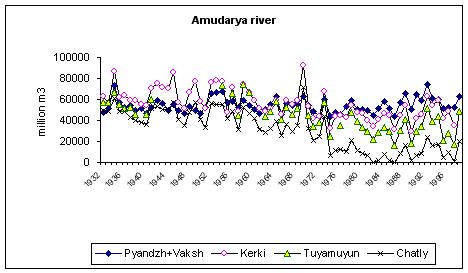
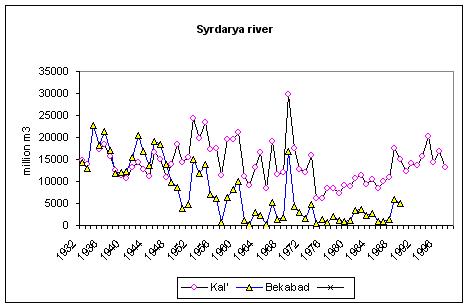
Figure 1. Dynamics of
annual flow as observed in river nodes over 1932-1998
Salinity dynamics as
observed in the main river nodes for 1932-1999 is shown in Figure
2.
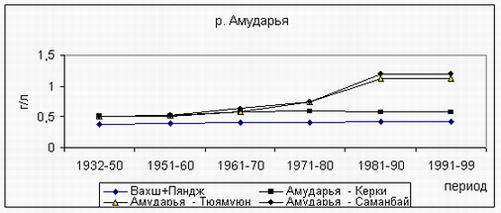
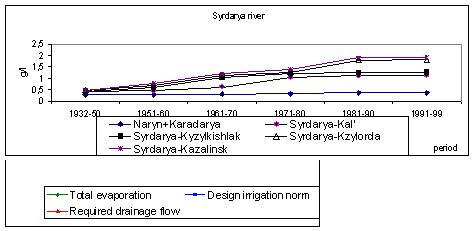
Figure 2. Water salinity
dynamics by the main river nodes
The above-mentioned
data indicate to growing crisis in water use practices in CAR caused
by the increase of consumptive use and pollution of water sources
by drainage and return waters, as well as by reduced seasonal and
long-term regulability of river flow. This violation of regulation
in the sources and their anthropogenic pollution create serious difficulties
for irrigated agriculture.
During growing season, drainage and waste waters having salinity of
3-5 g/l and more are used for irrigation in areas where irrigation
water of good quality is scarce (practically everywhere in low-water
years). The acceptability of saline water for irrigation or leaching
depends on both physical-chemical soil features and water chemistry
(Table 1).
Analysis of the acceptability
of high-saline water for irrigation
Acceptability of water for irrigation is determined by: salinity and
chemistry of irrigation water; hydraulic-physical features, grading,
and salinity of soil; degree of natural and artificial drainability;
general climatic conditions; groundwater level and chemistry; irrigation
rates, regime, and methods; farming techniques and crop characteristics.
Specific characteristics of soils in southern part of Central Asian
region, where most lands are irrigated, are prevalent fractions of
silt and low content of clay. As a result, cation exchange capacity
is low (to 10 - 15 mg-eqv/100 g). The soils contain a lot of calcium
and therefore the degree of soil buffering is high and, respectively,
alkalinity practically is not observed.
Within the framework of regional projects, such as WUFMAS, IWMI, Copernicus,
OIMP, etc., the chemical analyses were made of more than 3000 water
samples taken from different areas of Central Asia and a comprehensive
estimation of their quality was made, involving tests, according to
FAO's classification [4], for risk of soil alkalinization when using
these waters for irrigation. The obtained data may serve as a basis
for the development of database on water chemistry and salinity.
Table 1 Volumes and
quality of return waters in Uzbekistan*
|
River
basin
|
Volume,
million m3
|
River
reach
|
Quality
|
|
Return
flow
|
Contour
use
|
Drainage
water salinity, g/l
|
Sodium-
adsorption ratio (SAR*)****
|
|
Actual
|
Usable,
without flow transfer
|
Syrdarya
|
15503,0
|
885,0
|
6227,4
|
Upper
|
0,90-2,4**
|
1,04
- 4,11***
|
0,82
- 2,8***
|
|
|
|
|
Middle
|
3,4
- 8,45
|
2,00
- 15,00
|
2,20
- 18,20
|
Amudarya
|
22499,5
|
1715,9
|
2869,8
|
Upper
|
1,55
- 2,36
|
0,30
- 13,82
|
0,67
- 20,94
|
|
|
|
|
Middle
|
3,11
- 8,10
|
2,06
- 15,26
|
3,60
- 18,04
|
|
|
|
|
Lower
|
2,02
- 4,34
|
3,39
- 12,80
|
5,39
- 24,70
|
Total
|
38002,5
|
2600,9
|
9097,2
|
|
0,90
- 8,10
|
0,30
- 15,26
|
0,67
- 20,94
|
Note: * "Vodproyekt's"
data for 1988-1998 (taking into account availability of drainage flow
in the main collectors during the period of low-water years).
** Ministry's for Agriculture and Water Resources data (inter-farm
collectors).
*** SANIIRI's (Central Asian Irrigation Research Institute) laboratory
data (primarily on-farm collectors).
**** SAR* - indicator of potential alkalinization.
The analysis of 357
water samples having salinity between 0,215 to 70 g/l (samples taken
from more than ten points within the Amudarya and Syrdarya river basins)
showed that where water salinity varied within 0,3-6,0 g/l, SAR* was
not more than 9 (i.e. half-dangerous level in terms of alkalinization).
It is established that as to risk of alkalinization, waters with salinity
not exceeding 2 g/l and the soil water solutions with salinity reaching
4 g/l show SAR*=3 and are not hazardous, while waters having salinity
of up to 6 g/l and the soil water solutions having salinity of 9 g/l
are half-hazardous (SAR*=9). In case of higher salt concentrations
in water and the soil water solutions, there is a risk of alkalinization
since SAR*, as a rule, is more than 9. As to effect on soil percolation
properties, all analyzed drainage waters are not hazardous as salinity
of waters used for irrigation is usually not more than 0,5-2 g/l.
The theoretical ground
for using high-saline waters for irrigation purposes is that salt
concentration in these waters is much lower than that in the soil
water solutions. In case of irrigated soils, the optimal salt concentration
of the soil water solutions is 3-5 g/l; at salinity levels reaching
6 g/l we observe the slight reduction in plant growth; 10-12 g/l lead
to heavy suppression of growth, while salinity of 25 g/l causes death
of the plant [2].
Thus, theoretically water having the salt concentration of up to 3-5
g/l may be used (given free gravity flow and continuous water delivery)
without damage to the plants.
However, in practice
one should bear in mind the following for irrigation plots: the salt
tolerance of crops and of particular crop development phases; high
evaporation; inadequate control of salinization or soil osmotic potential;
untimely irrigation and low level of irrigation technologies; lack
of water outflow (including, due to shallow saline groundwater).
In this context, if
water salinity is more than 3 - 5 g/l, this water should be used carefully.
One should necessarily take into account both crop species and varieties
that can be more salt-sensitive. Use of drainage waters in order to
compensate shortage of irrigation water is more promising for cultivation
of salt-tolerant crops, such as cotton and winter wheat.
In case of using high-saline
water for irrigation, calcium is substituted by sodium and magnesium
(by 5-6% of the total) in absorbing complex. It is established that
the increase of adsorbed sodium in the soil is related to increased
soil salinity and is reversible, i.e. leaching and irrigation with
ordinary river water reduces the ratio of sodium and magnesium exchange
cations and raises calcium exchange cations [3]. Whereas the use of
saline water practically does not represent the risk of alkalinization
to given area, the risk of secondary salinization is high. Given the
low drainability of given area and the good preventive measures, there
exists a tendency to salt accumulation due to irrigation with saline
water, as was observed in the experiment carried out in Hunger Steppe
during six years [6]. During irrigation of cotton and alfalfa with
water having salinity of up to 5,3 - 5,9 g/l (at SAR* of up to 9,9
and irrigation norm of 5 - 5,5 thousand m3/ha) in combination with
leaching during non-growing season with water at salinity level of
not more than 1,5 g/l and at a norm of 2,4 thousand m3/ha the percentage
of salts and adsorbed cations in the soil changed seasonally. It was
observed that adsorbed sodium increased in the soil (in the sixth
year of irrigation - 15-25% of initial percentage), this in turn impacted
the intake rate of soil during first few hours of the observation.
Other changes in soil properties (capillary, field capacity, liquid
and plastic limits) were not observed. However, irrigation with water,
salinity of which is more than 1,5 g/l led to the reduction of both
cotton and alfalfa yields [5].
A possibility to leach
soil with saline water originates from the fact that salt concentration
of the soil water solutions in salinized land is higher as compared
to that of water. In order to evaluate a degree of water salinity,
which is acceptable for leaching, one can suppose that the soil water
solution could be desalinated to a level of salt concentration corresponding
to that of water.
A model developed together
with A.N.Morozov was used in elaborating approaches to soil water-salt
regime control under the conditions of long-term application of saline
waters. Model computations were made under the provision that during
irrigation with saline water of light soils (light loam, sandy loam,
sand) the salt concentration of soil water solution should be maintained
at a level that do not damage crop yield. As a result, they showed
that (Figure 3): at water salinity level of 2 g/l irrigation norm
must be increased by 5-7%; at 3 g/l, by 20%; and, at 4 g/l, by 30-50%.
In case of medium loam, even salinity of 2 g/l requires that application
of water be increased by 10%. Such increase in irrigation norm depends
on many aspects, and, first of all, on groundwater level and drainability
to ensure outflow of the additional water volumes.
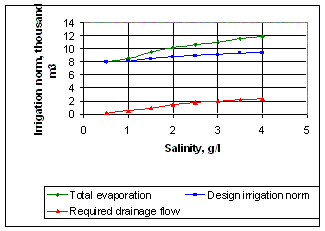
Figure 3. Predicted
increase in water consumption and drainage flow when using high-saline
water and maintaining good conditions for cotton growth (Karshi Steppe).
The simulation of water-salt
regime and change in annual irrigation norm in time under conditions
of Surkhandarya, using actual soil and climate parameters and different
degrees (slight, medium, high) of initial soil salinization in the
experimental plot and of irrigation water salinity (1,5 and 3 g/l),
while maintaining optimal for plants conditions to achieve 100% of
cotton yield, resulted in (Figure 4) that even at slight initial salinization
and irrigation water salinity of 1,5 g/l it is necessary to increase
irrigation norms (against practiced norms) at expense of leaching
fraction in order to maintain mentioned conditions in the long-term.
By the same reason, at high level of initial salinity at the beginning
of irrigation the higher norms of water application are required and
then as salinity decreases, the required norm is reduced too. The
required additional leaching fraction depends on the salinity of water
used for irrigation; consequently, irrigation norm is raised when
salinity increases. If irrigation water salinity is 1,5 g/l, in time,
the irrigation norm needed to maintain an optimal regime asymptotically
approaches 8000 m3/ha and comes to 10000 m3/ha at water salinity level
of 3 g/l. If initially the soils were not saline, then given irrigation
water salinity of 3 g/l, crops may be irrigated by the same irrigation
norms during four years.
Thus, long-term use of high-saline water requires that soil salinity
be controlled through leaching. The intensity of leaching directly
depends on the initial soil salinity and the salinity of water used
for irrigation.
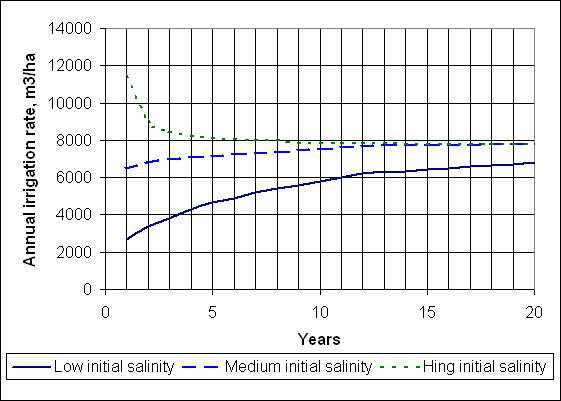
Figure 4. Predicted
changes in irrigation norms required to maintain acceptable for cotton
degree of salinity when using irrigation water at salinity level of
1,5 g/l. (Surkhandarya, medium loam)
To prevent accumulation
of salts in the aeration zone, it is desirable to use high-saline
water mainly for irrigation of light-graded and high permeable soils.
Currently, in fact, as outflow of groundwater is complicated due to
poor drainage, seasonal salinization of irrigated lands is mainly
caused by salts dissolved in groundwater and, to a lesser degree,
by quality of irrigation water. During evaporation often more salts
are brought to the rooting zone rather than during irrigation with
saline water.
Approximate balance
calculations made for some fields (using data of field observations
under WUFMAS Project, 1996-1999) showed that roughly the same amount
of salts is brought to the soil layer both from above and from below
when we irrigate with 7-8 thousand m3/ha of water, salinity of which
is 1,5 g/l and the groundwater depth is about 2 m and its salinity
is 5-7 g/l. In case of shortage of irrigation water, and even when
using drainage water with salinity of 3-4 g/l, major share of salts
comes from groundwater due to its high salinity - up to 18-20 g/l
(fields of Surkhandarya province). Thus, sometimes under-irrigation,
to a higher degree, creates a danger to crop yields and soil quality
than single irrigation with saline water.
Conclusion
Thus, the soil characteristics, water quality, and cropping patterns
in Central Asian republics enable us to relatively safely use collector-drainage
waters, taking into account that salt-tolerable crops (cotton, winter
wheat) are primarily cultivated in the region. The main negative effect
of such use is salt accumulation. Because of low soil sorption properties
and high ratio of calcium salts in water and soil, alkalinization
processes are practically excluded. Salt accumulation, as a rule,
leads to increase in percentage of exchangeable sodium and magnesium
in the absorbing complex. The experiments show that these processes
are reversible under desalination. Analysis of salts in local waters
and the soil water solutions allows for conclusion that water with
salinity of up to 9 g/l theoretically could be used at a certain risk
of toxic effects in plants (and, respectively, of yield losses) and
provided that concentration of salts is controlled and regulated by
timely irrigation. However, even water having salinity of more than
3-5 g/l should not be used. But in case of need, it is necessary to
take into consideration the type of irrigation crops since they have
different degrees of salt-tolerance which for some types changes by
development phases, as well as the soil permeability and grading.
At the same time, it is important to prevent salinization of soil
by regulating application of additional water volumes. Given the available
water and good outflow from the field, the above-mentioned is feasible
during growing season by performing more frequent irrigation or increasing
net norms. If there is lack of water during growing season and drainability
is poor, it is advised to leach the soil during non-growing season.
For the adequate planning of high-saline water use, the zoning of
irrigated lands is required, depending on available data on soil grading,
chemical composition and salinity of drainage waters, and actual drainability
of the area.
REFERENCES
1. Hillel D. Salinity Management for Sustainable Irrigation, 2000
2. Babayev A.Kh. Evaluation of water quality for the purposes of irrigation
or watering// Transactions-M., 1973 - p.12-23.
3. Glukhova T.P., Strelnikova G.A. Saline water in Uzbekistan as an
irrigation reserve - Tashkent: Faan, 1983.
4. Booker Tropical Soil Manual, edited JR Landon
5. Morozov A.N., Ignatikov V.N. Changes in soil properties and crop
yields under prolonged irrigation with saline waters// SANIIRI and
Sredazgiprovodkhlopok transactions.- Tashkent, 1986. p.53-62.
6. Shirokova Yu.I. The use of collector-drainage waters for leaching
of saline soils in the modern zone of Hunger Steppe: Author's abstract
- Tashkent, 1985.
How
to get in touch with us?
Return
to the main page
|

